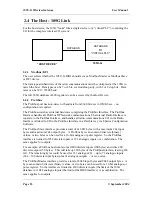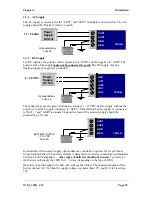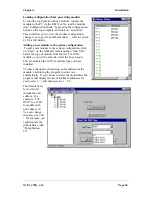
105U-G Wireless Gateway
User Manual
Page 29
© September 2004
transmission range will be, however as the length of coaxial cable increases so do cable
losses. For use on unlicensed frequency channels, there are several types of antennas
suitable for use. It is important antenna are chosen carefully to avoid contravening the
maximum power limit on the unlicensed channel - normally the net gain of the
antenna/cable configuration should be no more than 2dB.
The net gain of an antenna/cable configuration is the gain of the antenna (in dBi) less the loss
in the coaxial cable (in dB).
The gains and losses of typical antennas are
Antenna
Gain (dB)
Dipole with integral 3m cable
0
Dipole without cable
2
5dBi Collinear(3dBd)
5
8dBi Collinear (6dBd)
8
3 element Yagi
5
6 element Yagi
10
Cable type
Loss (dB per 10 m)
400-500MHz
869MHz
RG58
-3
-5
RG213
-1.5
-2.5
Cellfoil
-1.5
-3
The net gain of the antenna/cable configuration is determined by adding the antenna gain and
the cable loss. For example, a 3 element Yagi with 15 metres of RG58 has a net gain of
0.5dB (5dB – 4.5dB) at 450MHz.
Connections between the antenna and coaxial cable should be carefully taped to prevent
ingress of moisture. Moisture ingress in the coaxial cable is a common cause for problems
with radio systems, as it greatly increases the radio losses. We recommend that the
connection be taped, firstly with a layer of PVC Tape, then with a vulcanising tape such as
“3M 23 tape”, and finally with another layer of PVC UV Stabilised insulating tape. The first
layer of tape allows the joint to be easily inspected when trouble shooting as the vulcanising
seal can be easily removed.
Where antennas are mounted on elevated masts, the masts should be effectively earthed to
avoid lightning surges. The 220MHz and 400 – 500MHz radios are fitted with surge
protection, however the 868MHz radio does not. For high lightning risk areas, additional
surge suppression devices are recommended. If the antenna is not already shielded from
lightning strike by an adjacent earthed structure, a lightning rod may be installed above the
antenna to provide shielding.
3.2.1
Dipole antenna.
A unity gain dipole is the normal antenna for use on unlicensed channels. As it does not
provide any gain, then the power transmitted from the antenna will be the same as the power
out of the module, and hence will not exceed the permitted power of the unlicensed channel.
















































